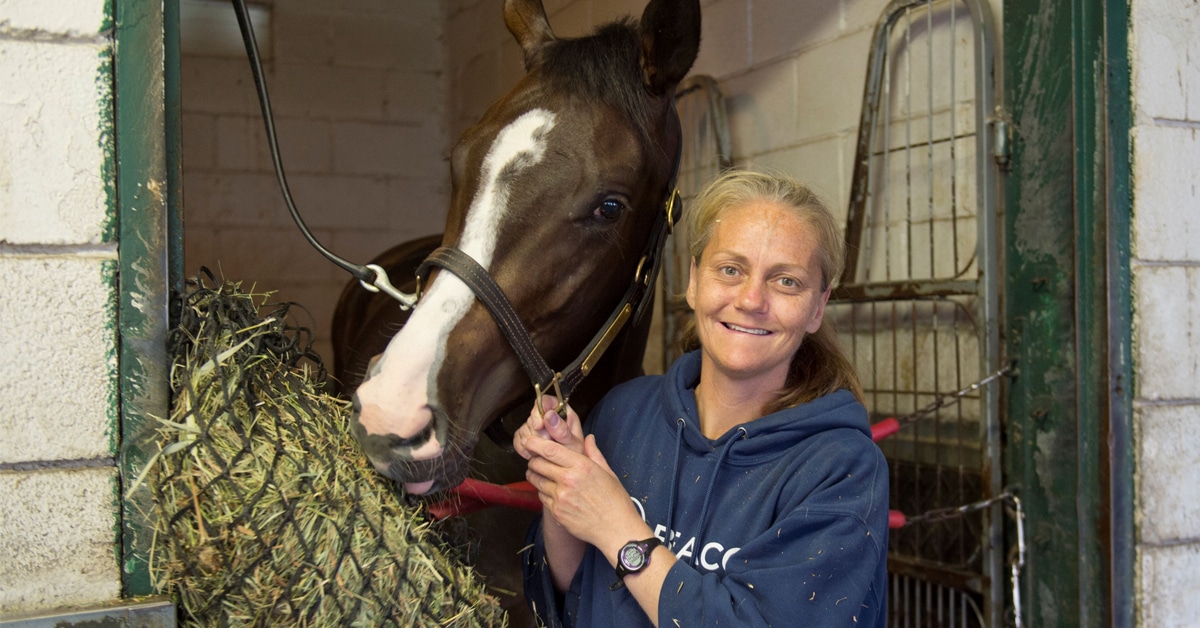“The look on a great Thoroughbred’s face when they come to the gate – you have to be up close and personal to see it.”
Every time the starting gates spring open and the horses leap from the stalls to charge down the track, you have Clay Puett to thank.
Born in 1899, the Texan invented the closed electric starting gate which is now used at all major thoroughbred race tracks around the world in some form or another. And it was actually right here in Canada ‒ at Exhibition Park Race Track in Vancouver, BC ‒ where Puett’s invention made its debut on July 1, 1939.
Prior to Puett’s starting gate a number of mostly unsuccessful techniques were used. In the mid-19th century a starter would stand beside the horses and jockeys, drop his flag to signal the start, while his assistant 100 yards down the track had a second flag to mark a false start. Later, racehorses were routinely sent off from behind spring-loaded ropes, wires or cloth or webbed barriers which would fly upward. This also proved to be a recipe for disaster (and more false starts), leading to many injuries and other mayhem. In one incident at the 1924 Kentucky Derby, a horse named Bracadale finished fifth, trailing a piece of the barrier behind him for part of the trip.
Puett, who died in 1998 at the age of 99, started the manufacturing company True Center Gate in 1958; it still producing starting gates for the industry based on the founder’s revolutionary design.
Behind the Gate at Woodbine
Ian Ross has been the head starter at Woodbine for over 10 years, managing a gate crew usually numbering about 14. The road to his current position was a bit long and winding; he began working on the gate under head starter Sam Hall in 1980, then started an equine dentistry practice in 1984. He worked privately for some of the bigger outfits including Adena Springs, then ended up at Ajax Downs on the gate with the quarter horses. “I really, really enjoyed it,” said Ross. “They were so good to me there that when Woodbine came along it was a really tough decision to make.”
But he has no regrets, and is proud of his team at the Rexdale oval, their respectful, humane handling of the horses, and their admirable safety record. “That is one thing I am so strict about. We care about the horses. It’s our business and our life ‒ respect for the animal.”
That’s not to say there aren’t plenty of horses who do their best to make life difficult for the crew. “Over the years I’ve had some very, very difficult horses,” he says. “But we’ve taken two, three, four months and we got that horse to the races. That’s the most satisfying feeling in the world.”
“It’s our business and our life ‒ respect for the animal.”
But not all horses are suited to the sport. Ross singles out an example. “I had one horse who would come in the morning, walk in and not make a move. But in the afternoon he would not load. We got away with it for a while, but he would want to hurt you; he would kick like I’d never seen and it’s not worth any of the guys getting their knee taken off. We tried blindfolds, blinkers; if he knew you were back there, he was kicking. We had to let this horse go [bar him]; he was trying to tell us ‘no more’ for whatever physical or mental reason. Someone has to stand up and speak for the horses.”
He stresses that every horse is unique. “You have to know what you’re working with. You’ve got to know the difference between horses that are acting ornery, and ones that are just scared.”

Ian Ross gives the thumbs-up. (Will Wong photo)
The bottom line? “It’s all about safety,” Ross says. “We have one of the best records in North America; very few scratches at the gate. We’re very proud of that.” Ross credits his great crew and the team of Jessica Buckley, Martha Scott and Karl Lagerborg. “When it comes to safety they always ask ‘What can we do to make it better?”
Regarding the hardware itself, the gates at Woodbine are custom-made and a lot of effort is put into them to keep them up-to-date and safe. And they are expensive.
“To buy a starting gate ‒ even a cheap one ‒ they are normally around $10,000 per stall,” he notes. Some gates are spring-loaded; Woodbine’s are hydraulic. “Both styles of gate are good but I really like ours because our doors are quieter and it keeps the horse tighter so they stand better.” Powerful electromagnets keeps the doors shut and when Ross hits the button it releases all the magnets simultaneously. The generator in the truck also powers the lights for night racing. And there is a tractor handy as backup in case (yikes) the truck will not start after the horses have left the gate.
They’re Off at Century Mile
Brian ‘Wally’ Walper of Leduc, Alberta, is the assistant starter at Century Mile in Edmonton, a position he has held for the past three years. This year marks Walper’s 15th year working the gate, with a dozen years spent previously at Northlands.
Like Ross, Walper’s path to his current career took a lot of detours. “I trained for 24 years, outrode for a couple of years at Stampede Park, I helped clock, I still help saddle horses when we’re short of valets. It’s a little more hectic when you’ve got to run back and forth and saddle, but you do what you’ve got to do to get the card off.”
Brian’s wife, Deanna, has been a trainer for 19 years and has 20 horses in training at the track. “I help her in the morning and another lad from the gate helps us at the barn. When it’s time for the gate to open we go over and open it up for an hour and a half every morning.”
His gate crew typically ranges between 11 and 13, including eight ‘headers’ and two ‘pushers’. “Sometimes guys don’t come back [after the winter], so you’ve got to retrain new guys.”
Walper describes his team’s method of acclimating the newbies to the gate. “If they’re really good, they go through the gate six to seven times. The first time is a walk-through with the front open to let them get used to the closeness of the metal on the sides of the gate. The second time we’ll lock them in, and the third time we’ll lock them in and just kind of shoot them out a little. The fourth and fifth time they’ll flat foot [get sent out a bit faster], and then they’ll bell twice and if everything goes good, they’re okay. If not, they’ll keep coming back.”
And how much of an incentive is that starting bell, really? Says Walper, “When Century Downs was down in Balzac, they bought an old gate and there were times where the bell wasn’t working. And the horses still broke well … I’m sure they’re keyed into when the gate opens, but the bell helps encourage the odd one.”
Back in Rexdale, the training procedure at the Woodbine gate is similar: the first time a horse is loaded, only the back doors are closed. The second time the back and front doors are closed and an assistant starter will stand next to the stall while the front gate is ‘hand-popped.’ The third time the horse is loaded, the front and back doors are closed and the assistant starter climbs up and down 2 or 3 times so the horse gets used to it, and then the switch is used to open the front. “We will do that five or six times; then the gate is taken to the 1/4 pole and we pop them out of the gate maybe twice and let them run 100 yards,” explains Ross. “So now the horse may have been exposed to the gate seven times before they ever get worked from the gate. It is so important at the beginning; you have to do all the right things or you can ruin them forever.”
Ross spends the mornings at the schooling gate where the babies are introduced. “I watch how every horse reacts so I can tell which ones are going to need more work.”
Every horse is different, of course, and some just never relax. “We can school horses for a year straight but they are just never comfortable enough to stand there for 20 seconds without exploding. Rather than risking getting that horse hurt, we’ll load him late, or load him second or third and back him out – just give him that little bit of a break. That way the horse isn’t going to get hurt, the jock’s not going to get hurt, and neither is anyone on the gate.”
“Our pontoons are made out of aluminum and a lot of the ‘girls’ don’t like cold hands touching them!”
What about horses that won’t leave the gate? “I’ve had that happen, too,” says Ross. “You’ve got to catch that if they start leaving slower and slower and find out why they are doing that.” He says that sometimes the hesitation is caused by discomfort in their back or stifles when they push off.
Ross keeps records on all the horses, how they behaved, and how to make them calm and confident. No trainer wants their horse to land on the dreaded Starter’s List, unable to race again until they are re-schooled to the satisfaction of the head starter. “It depends what their problem was,” says Ross as to how quickly they are cleared to race once more. “If in the afternoon they won’t load, they have to show me they can walk in. I can’t have horses taking four or five minutes while other horses are standing in the gate. The idea is to be fair to every horse.”
Security Blankets

Monty Roberts Blanket.
Monty Roberts designed a special blanket in 1992, prompted by a horse named Prince of Darkness who, according to Roberts, “could be a perfect gentleman, or a killer on a moment’s notice. He considered the starting stalls to be small and frightening … he would fight like a tiger to protect himself from the invasive walls.” Protected with a thick blanket that draped over his sides and hips down to the hocks, the colt became a winning racehorse.
Ross uses the blankets on occasion at Woodbine. “Ninety-five percent of the time it’s a filly,” he explains, laughing. “Our pontoons are made out of aluminum and a lot of the ‘girls’ don’t like cold hands touching them!” When they walk in and feel the cold on their hips, some will fuss or try to sit down. The blanket protects them from the sensation and has a ring attached into which a rope is snapped so that the blanket slides off as the horse leaves the gate ‒ ideally. “Down in the States I’ve seen them come out of the gate with the blanket on, and that’s not good!” warns Ross.
Close Calls
“One day I’ll never forget, we had the horses come up to the gate, on the turf going a mile and a 1/16th,” recalls Ross. “They were just getting to the gate and I can see this storm coming in ‒ fast. I had two horses in the gate and I said ‘back them out!’ They all made it back to the Standardbred barn just in time, but I have never seen it rain like that. We were lucky ‒ it was really scary and a lot of bad things happened that day in that storm.”
Over at Century Mile, one incident in particular stands out to Walper. “Because our gates are metal and there’s no padding on the inside, we have a blanket that we throw over top of the horses [who need it].” And this is not a Monty Roberts blanket, Walper is quick to point out; “this one we probably had longer than Monty Roberts! Our original one we made out of carpet.

Brian and Deanna Walper with their daughter Amber (also in the racing biz) on their well-earned Hawaiian trip. (Photo courtesy Brian Walper)
“We put this blanket on a horse my wife trained, Rocky Raccoon. The horse the year before had a bad experience in the gate and threw a big wreck. I was leading him in with the blanket and as he got halfway in he stopped. I gave him a few seconds to get used to things … and then he took a lunge and jumped on top of me! He broke my nose and my glasses.
“We got him closed in, but he was still standing on my head and they dragged me out of there. We got back to the barn and my wife says ‘now what are we gonna do?’ and I said ‘you’re gonna put polos on him and you’re going to send him right back to the gate and we’re gonna do it all again.
“We got him closed in, but he was still standing on my head and they dragged me out of there.”
“It took us quite a while, but we did get him in there and got him racing and he ended up winning a race. So the owner sent me and my wife and our daughter to Hawaii for two weeks. It was grand.”
Another odd story Walper shared involved an injury not sustained at the gate. “One year I was on the gate and the outrider quit, so they conned me into outriding that day. In the last race of the day a horse got loose from behind the gate and I set up for the catch – but when I caught the loose horse and sat back down in the saddle, my pelvis broke. So off to the hospital I went. My wife found out later and was not happy.”

The winners circle photo at Northlands Park with Argentune, trained by Deanna Walper (far left) – Wally would be the guy on the crutches. (Coady photo)
Downsides, Upsides
“The worst is when things go wrong because I take things personally,” admits Ross. “I know how hard the trainers work and what it takes to get a horse there. If I push that button and boom, something happens, I’m the one in charge and it’s my fault. In a second they can do something with their head and then the horse gets left behind and the owner and trainer go ‘aagggh!’ That’s horse racing, but we still do our best.”
The best thing about the job? Ross says without hesitation: “Starting the Queen’s Plate. It’s such a tradition. And working with great horses, great trainers, great jockeys.
“Some of the horses I’ve been around over the years blow my mind. Play The King, Roger Attfield’s horse. Wise Dan was a great horse, too. The look on a great Thoroughbred’s face when they come to the gate – you have to be up close and personal to see it. They are true athletes; you can see the look in the horses how much they love it. It is really cool.”
The Latest










